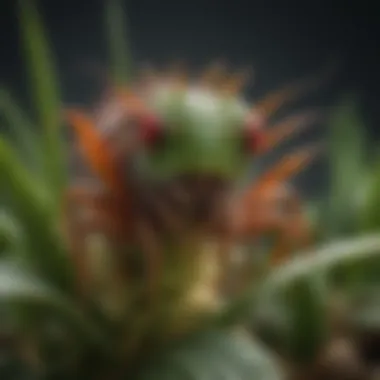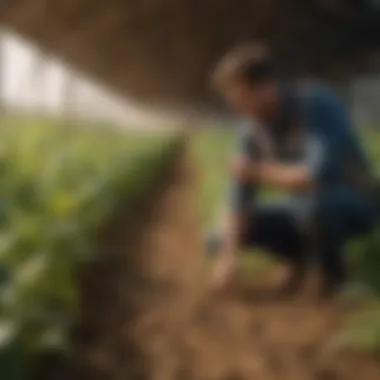Innovative Pest Management: Agrisure Viptera and Duracade


Intro
Agriculture faces numerous challenges, particularly when it comes to pest management. Pests can diminish crop yields and impact farm profitability. To combat these issues, innovations in crop genetics are essential. Two significant advancements in this area are Agrisure Viptera and Duracade, developed by Syngenta. These traits are engineered to enhance corn's resilience against key pests, making them crucial to modern agriculture.
This in-depth analysis will provide a clear understanding of their genetic composition, mechanisms of action, and implications for sustainable farming practices. The insights will help agricultural professionals navigate the complex landscape of pest management and make informed choices for their operations.
Key Concepts and Terminology
Definition of Terms
Understanding the specific language of pest management is essential. Here are key terms related to Agrisure Viptera and Duracade:
- Pest Resistance: The ability of cultivated plants to tolerate or withstand pest attacks due to genetic modifications.
- Transgenic Traits: Characteristics introduced into a plant through genetic engineering, often to enhance resistance to specific diseases or pests.
- Biotechnology: The use of living systems and organisms to develop or create useful products, a notable application in crop improvement.
Overview of Relevant Practices
Farming practices that incorporate genetically modified organisms (GMOs) such as Agrisure Viptera and Duracade include:
- Integrated Pest Management (IPM): A holistic approach that combines different management strategies and practices to control pests in an environmentally and economically sound manner.
- Crop Rotation: Rotating different crops in and out of a field to disrupt pest life cycles and improve soil health.
- Precision Agriculture: Utilizing technology to monitor and manage field variability, leading to improved crop efficiency and reduced environmental impact.
Current Trends and Innovations
Latest Research and Developments
Recent studies highlight enhancements made through Agrisure Viptera and Duracade in corn’s defense against pests like the European corn borer. Research indicates that these traits significantly decrease pest infestation rates, contributing to increased yields and sustainability. These advancements directly address emerging agricultural challenges, such as climate change and evolving pest resistance.
Emerging Technologies and Tools
In the sphere of pest management, technology is continuously evolving. Notable tools include:
- Remote Sensing Tools: Drones and satellites that help farmers monitor crop health and detect pest infestations early.
- Mobile Apps: Applications that assist farmers in identifying pests and diseases using image recognition.
- Data Analytics: Utilizing big data to predict pest outbreaks based on climatic conditions and crop performance.
Practical Applications
Step-by-Step Guides
Implementing Agrisure Viptera and Duracade requires understanding key practices:
- Evaluation of Suitable Traits: Determine which traits best address the specific pest issues in your region.
- Soil Testing: Conduct soil tests to assess nutrient requirements and health before planting.
- Planting Strategies: Utilize best practices for planting corn, including spacing and timing to optimize crop resilience.
- Monitoring Growth: Regularly inspect crops for signs of pests or stress, adjusting management practices as needed.
Troubleshooting Common Issues
Challenges may arise while using genetically modified corn.
- Pest Resistance Management: Rotate pest-resistant traits to prevent pests from developing resistance.
- Environmental Factors: Monitor weather conditions that may impact pest pressures and crop growth.
- Market Acceptance: Be informed about consumer attitudes towards GMOs and adjust marketing strategies accordingly.
The integration of advanced traits like Agrisure Viptera and Duracade signifies a pivotal shift in pest management strategies aimed at ensuring sustainable agriculture.
This analysis seeks to provide a comprehensive view of the innovations brought by Agrisure Viptera and Duracade. As agricultural challenges evolve, embracing these advancements will be necessary for successful pest management and overall farm viability.
Prologue to Agrisure Traits
The innovations in pest management through Agrisure traits represent significant advancements in agriculture. These traits are essential for enhancing the resilience of crops against various pests, thus ensuring better yield and farming sustainability. In this section, we will explore the importance of genetically modified organisms (GMOs) in agriculture as well as Syngenta's role in revolutionizing pest control through their unique traits.
Understanding Genetically Modified Organisms


Genetically modified organisms (GMOs) are organisms whose genetic material has been altered using biotechnology. This process enables the introduction of specific traits that can improve resistance to pests, diseases, and environmental conditions. In the context of Agrisure traits, these modifications allow corn to resist specific insects like the corn earworm or the western corn rootworm, which can significantly damage crops.
The implementation of GMOs in agriculture has countless benefits:
- Improved Yield: With pest resistance, farmers can experience higher yields due to less crop damage.
- Reduced Pesticide Use: Farmers can rely less on chemical pesticides, leading to fewer environmental impacts.
- Enhanced Food Security: With increased efficiency in crop production, GMOs can contribute to global food security.
However, it is important to note that GMOs also face scrutiny regarding health and environmental safety. Public perceptions range from strong support due to productivity benefits, to skepticism shaped by concerns over ecological impacts and food safety. The conversation surrounding GMOs is complex and layered and continues to evolve over time.
Overview of Syngenta Innovations
Syngenta, as a leading global agribusiness, is at the forefront of developing and implementing innovative agricultural solutions. The company's focus has been on enhancing crop protection and promoting sustainable practices. Agrisure traits are one such innovation that exemplifies Syngenta's commitment to farming advancements.
These innovations are characterized by:
- Research and Development: Heavy investment in R&D to create traits that effectively resist pests while maintaining crop health.
- Field Testing: Extensive testing and trials in diverse farming conditions to ensure effectiveness before launch.
- Collaboration: Working closely with farmers to understand needs and improve solutions based on real-world feedback.
"Syngenta's mission is to help farmers effectively manage pests while promoting sustainable practices that benefit both productivity and the environment."
By offering traits such as Agrisure Viptera and Duracade, Syngenta not only addresses immediate pest challenges but also supports broader goals of food security and sustainability in agriculture. As we dive deeper into these traits, we will uncover the scientific underpinnings and their implications for modern farming.
The Science Behind Agrisure Viptera
The Agrisure Viptera trait represents a breakthrough in pest management within modern agriculture. It offers a sophisticated solution to a persistent challenge faced by corn growers: invasive pests that threaten crop yield and integrity. Understanding the science behind Agrisure Viptera is vital for both agricultural professionals and enthusiasts, particularly in terms of its genetic foundation, mechanisms of action, and overall impact on farming practices. As the agricultural industry evolves, enhancing crops to resist pests becomes increasingly important for sustainability and food security.
Mechanism of Action
The core of Agrisure Viptera's efficacy lies in its unique mechanism of action. This trait incorporates the Cry3Bb1 protein, derived from the bacterium Bacillus thuringiensis. When pests ingest corn containing this protein, it binds to specific receptors in their gut. This interaction disrupts the digestive processes, leading to the pest's eventual demise. The specificity of this protein ensures that it primarily targets certain insects without harming beneficial organisms. Thus, Viptera offers a targeted approach to pest control, minimizing unnecessary disruption to the ecosystem.
Target Pests and Pathogens
Agrisure Viptera is engineered to combat a range of pests that commonly afflict corn crops. Notable targets include:
- European Corn Borer: A significant pest that can cause extensive damage to corn.
- Western Bean Cutworm: Known for its destructive feeding habits on corn kernels.
- Fall Armyworm: An increasingly problematic pest that can cause severe impact on yields.
The trait's ability to address these pests makes it a formidable option for farmers who are looking to protect their crops from multifaceted threats. In addition to insects, it also provides resilience against certain pathogens, bolstering overall plant health.
Field Performance Analysis
To assess the real-world effectiveness of Agrisure Viptera, extensive field trials have been conducted. These reveal that crops containing the trait demonstrate markedly better resistance to pest infestations compared to those without it. Key findings from these analyses include:
- Increased Yield: Corn with Viptera often yields significantly more than crops exposed to high pest pressure.
- Reduced Insecticide Use: With the effectiveness of this trait, some farmers have reported lower dependence on chemical insecticides, aligning with sustainable farming practices.
Implementation of Agrisure Viptera thus presents a dual advantage: it enhances yield potential while also promoting environmental stewardship. This performance evidence underlines the importance of continued investment in biotechnological innovations to bolster crop resilience.
The incorporation of Agrisure Viptera into farming systems exemplifies how science can offer practical solutions to age-old agricultural challenges.
Exploring Duracade Trait
The exploration of the Duracade trait is critical in understanding modern pest management techniques in agriculture. Developed by Syngenta, Duracade is noteworthy not only for its genetic makeup but also for its strategic application in crop resilience. This trait offers a robust answer to the challenges that corn farmers face in sustaining crop productivity and maintaining profitable practices.
The key components of Duracade include its specific mechanisms of action, diverse pest resistance capabilities, and the insights gained from field trials. Each of these elements contributes significantly to the overall effectiveness of this trait in real-world agricultural scenarios.
Mechanism of Resistance
Duracade functions primarily through a specific mechanism of action that targets common corn pests. It is designed to be resistant to multiple forms of pest attacks, which minimizes the economic losses typically incurred by farmers. The trait impedes the larvae of the European corn borer and other pests from developing properly, thereby effectively reducing their populations in the field. This method of interference is vital, as it decreases the reliance on chemical pesticides, promoting a more sustainable farming approach.
The genetic modification achieved in Duracade utilizes a unique protein that is lethal to these pests but safe for human consumption and non-target organisms. This specificity ensures that the ecological balance is maintained while offering farmers a defense against harmful agricultural impacts.


Diverse Pest Resistance Capabilities
One of the most significant advantages of Duracade is its diverse pest resistance capabilities. Unlike traditional methods that target a single type of pest, Duracade has been engineered to defend against a range of agricultural threats. This multipronged strategy lessens the likelihood of pests developing resistance to the trait itself, which is a robust advantage for farmers looking to maintain high yield over multiple growing seasons.
Studies reveal that Duracade shows effectiveness against pests such as the western bean cutworm, along with other troublesome insects. This versatility in pest control broadens the options available for integrated pest management and ensures that growers are equipped to handle various pest pressures without interrupting their farming operations.
Field Trials and Data Insights
Field trials have played a pivotal role in assessing the performance of the Duracade trait. Numerous test results illustrate its positive impact on yield and overall plant health.
Data show that corn crops with the Duracade trait tend to exhibit less feeding damage and improved growth parameters compared to control groups. For instance, trials conducted in diverse geographical regions have confirmed that Duracade consistently outperforms traditional hybrids in terms of pest resistance and yield stability.
Also, insights gleaned from these trials emphasize the economic implications for farmers. The cost savings associated with reduced chemical usage combined with higher yields contributes to a better return on investment. As a result, the adoption of Duracade among farmers can lead to greater sustainability in corn production.
"Duracade represents a significant advancement in agricultural biotechnology, offering practical solutions to meet today's pest management challenges."
In summary, exploring Duracade’s traits illustrates its essential role in modern pest management strategies. With its scientifically engineered mechanisms of resistance, extensive pest control capabilities, and promising outcomes from field trials, Duracade stands out as a vital tool for farmers in achieving sustainable agricultural practices.
The Duracade trait not only bolsters the efficacy of pest management but also opens pathways to innovative agricultural solutions that can safeguard future harvests.
Comparative Analysis of Viptera and Duracade
The comparative analysis of Agrisure Viptera and Duracade is essential in understanding their roles in modern pest management strategies. Corn farmers face numerous challenges, including pests that threaten yields and ultimately profitability. Thus, evaluating these traits provides key insights into their effectiveness, adaptability, and economic impact. By examining how each trait operates under various environmental conditions, as well as their economic implications for farmers, we can better appreciate their contributions to sustainable agriculture.
Efficacy in Diverse Environmental Conditions
Understanding the efficacy of Agrisure Viptera and Duracade in varied environmental conditions is crucial for farmers seeking resilient crop solutions. Each trait demonstrates unique responses to changing climates and pest pressures.
- Agrisure Viptera was developed to combat certain pests, particularly those in the order Lepidoptera. It features a unique mechanism that expresses a protein, Cry34/35Ab1, targeting specific insect pests, thereby reducing their impact on corn crops. In regions with high pest pressure, Viptera shows consistent performance in ensuring yield protection.
- Duracade, meanwhile, incorporates a broader spectrum of pest resistance, including rootworms and other economically important pests. Its design allows for better performance in challenging environments where pests evolve and adapt. For instance, Duracade's resistance to western corn rootworm includes enhanced effectiveness even in fields previously treated with other pest management solutions.
Moreover, field trials indicate that both traits maintain high levels of efficacy not only in optimal growing conditions but also in situations of drought or excess moisture. Understanding these dynamics can help farmers decide which trait may be ideal for their specific conditions. Consequently, careful assessment allows for tailored pest management strategies that consider local environmental factors.
"Choosing the right trait for pest resistance is not just about effectiveness; it’s about sustainability and economic viability for the future."
Economic Implications for Farmers
Economic factors play a significant role in the decisions farmers make regarding pest management. Both Agrisure Viptera and Duracade offer distinct economic advantages that merit consideration:
- Farmers who employ Agrisure Viptera often experience reduced input costs related to chemical insecticides. Significant savings can be accrued from decreased pesticide applications, allowing funds to be allocated to other vital farming operations. Furthermore, consistent yield protection can lead to improved revenue streams.
- On the other hand, Duracade provides farmers with resilience in pest control, particularly against resistant pest populations. The initial investment in Duracade may be higher, but the long-term benefits from less frequent crop failures justify this cost. Additionally, as agricultural markets evolve, having traits like Duracade that adapt to emerging pest threats may safeguard farmers’ financial futures.
Regulatory and Ethical Considerations
Understanding the regulatory and ethical landscape surrounding genetically modified organisms (GMOs) is crucial for the adoption and sustainability of traits like Agrisure Viptera and Duracade. Regulations play a vital role in shaping public and farmer confidence in such innovations. These frameworks aim to ensure the safety of GMOs for human consumption, environmental impact, and agricultural biodiversity.
As farmers and agricultural professionals explore these advanced traits, it is important for them to navigate the regulations set by various governing bodies. In many countries, stringent assessments are required before GMOs can be commercially cultivated. This involves comprehensive evaluations concerning genetic stability, potential allergenicity, and ecological effects.
The importance of this topic extends beyond mere compliance. Engaging with regulatory considerations can lead to informed decision-making that enhances acceptance and trust. As such, the potential benefits of Agrisure Viptera and Duracade are tied closely to the proven compliance with these regulations.
International Regulations Affecting GMOs
Globally, the regulation of GMOs is not uniform. Different regions have distinct approaches, which can significantly influence market access for traits like Agrisure Viptera and Duracade.
- The European Union is known for its rigorous stance. Regulatory bodies require extensive pre-marketing assessments, encompassing long-term environmental monitoring. Moreover, labeling of genetically modified foods is mandated to ensure consumer transparency.
- In contrast, the United States has a more permissive regulatory framework, governed by the USDA, EPA, and FDA. Here, the focus is on assessing the risks associated with the traits rather than the process of genetic modification itself.
- Other markets, such as Canada and Brazil, adopt hybrid approaches, integrating both science-based assessments and public engagement frameworks to address stakeholders' concerns.
The divergent international regulatory environment creates both challenges and opportunities for companies like Syngenta. Understanding these variations can help farmers and agribusinesses better strategize their operations and marketing.
Public Perception and Consumer Trends


Public perception of GMOs is a topic that cannot be ignored. It wields considerable influence over market dynamics.
Surveys indicate that consumer acceptance of GMOs often hinges on several factors:
- Trust in scientific assessment and regulatory bodies.
- Awareness of the advantages provided by traits like Agrisure Viptera and Duracade, such as reduced pesticide use and increased yield stability.
- Socioeconomic status, education, and cultural attitudes towards food technology.
New trends reflect a growing curiosity among consumers regarding where their food comes from, including how it is produced. This has spurred interest in transparency. Many consumers are more likely to support products and companies that commit to ethical practices regarding GMOs.
"The impact of media coverage on GMOs can shape public opinion significantly, highlighting the need for clear communication strategies from producers."
Thus, for farmers considering Agrisure Viptera and Duracade, embracing transparency and effective communication about these traits’ safety and benefits is paramount. Addressing concerns head-on can foster a more favorable perception and heightened acceptance across markets.
Sustainability and Future Perspectives
Sustainability is a crucial point in today’s agricultural practices. The integration of genetically modified organisms (GMOs) like Agrisure Viptera and Duracade into farming systems raises both opportunities and challenges for sustainability. This section will explore these elements in detail, examining how these innovations can contribute to sustainable agricultural practices.
Integrating GMOs into Sustainable Practices
Integrating GMOs such as Agrisure Viptera and Duracade can have a profound impact on sustainable agricultural practices. These traits offer various benefits that align with sustainability goals. For instance, they can reduce reliance on chemical pesticides, which in turn can lessen environmental contamination and protect beneficial insect populations. This integration leads to a more balanced ecosystem within agricultural settings.
Some specific benefits of using GMOs in sustainable practices include:
- Improved Pest Resistance: These traits provide corn plants with inherent resistance against certain pests, limiting the need for external pesticide applications.
- Enhanced Yield Stability: With reduced pest damage, farmers can witness improved and more predictable crop yields, which is essential for food security.
- Soil Health and Conservation: By minimizing chemical inputs and adopting biotechnological solutions, GMOs can promote healthier soil conditions and reduce erosion.
Despite these advantages, challenges remain in incorporating GMOs sustainably. Public perception, market acceptance, and environmental concerns often require farmers to navigate complex scenarios. Nonetheless, the goal remains clear: the responsible use of GMOs can complement sustainable farming methods.
Future Innovations in Pest Management
The landscape of pest management is continually evolving. Current research and development efforts are paving the way for future innovations that will further enhance the effectiveness of traits like Agrisure Viptera and Duracade. These innovations will likely revolve around enhancing genetically modified traits, exploring biocontrol methods, and utilizing cutting-edge technologies.
Future innovations may include:
- CRISPR Technology: This gene-editing technology holds promise for creating crops with enhanced pest resistance tailored to specific regions or conditions.
- Biological Control Agents: Using beneficial organisms to manage pests can create a more sustainable approach. This avenue will likely be explored in tandem with GMOs.
- Smart Agriculture Technologies: Advances in precision agriculture technologies, including drones and sensors, can provide farmers with real-time data to make informed pest management decisions.
In summary, the future of pest management will likely see a blend of current GMOs and emerging technologies working together to create a more sustainable agricultural environment. By focusing on these innovations, the agricultural sector can reinforce its commitment to sustainability while effectively managing pest issues.
"The thoughtful integration of GMOs into pest management strategies will be critical to achieving sustainable agriculture in the years to come."
Collaboration among scientists, farmers, and policymakers will be essential to navigate the complexities of these innovations effectively and thoughtfully.
End
In this article, we have explored the significant advancements brought forth by Agrisure Viptera and Duracade in the realm of pest management. These innovations are not just about improving yields; they signal a shift toward more sustainable agricultural practices. The importance of understanding how these traits function, their impact on the environment, and their economic benefits cannot be overstated.
The insights gained from analyzing these traits illuminate several key aspects:
- Genetic Resilience: The incorporation of genetically modified organisms has fundamentally altered how farmers approach pest control. Viptera and Duracade demonstrate effective pest resistance, leading to healthier corn crops.
- Field Performance: Through rigorous testing and trials, the efficacy of these traits in variable environmental conditions has been confirmed. This adaptability is crucial, as climate challenges continue to rise.
- Economic Viability: Cost-effectiveness is a vital consideration. Farmers adopting these traits can expect improved profitability through reduced pesticide expenses and increased yields.
- Sustainability Considerations: Integrating these technologies aligns with sustainable farming goals. Emphasizing responsible use of resources while also considering the ecological impact is essential for long-term agricultural success.
Overall, the conclusion we draw is that Agrisure Viptera and Duracade represent crucial steps in enhancing agricultural resilience and sustainability. By focusing on pest management through innovation, we are better equipped to face future challenges in food production.
Summary of Key Findings
The primary findings from this in-depth analysis highlight the following points:
- Mechanisms of Action: Both Agrisure Viptera and Duracade utilize sophisticated biological methods to combat pests, providing farmers with robust tools to manage threats effectively.
- Target Pests: These traits have shown effectiveness against a wide range of pests, minimizing reliance on traditional pesticide methods, which can have broader environmental impacts.
- Regulatory Environment: The evolution in policies and public perception surrounding GMOs plays a significant role in the adoption of these innovations in farming practices.
Implications for Future Research
Future research directions should focus on several vital areas:
- Long-term Environmental Impact Studies: Understanding the ecological effects of GM crops over extended periods will provide a clearer picture of sustainability.
- Integration with Other Agricultural Practices: Exploring how Agrisure Viptera and Duracade can be combined with other pest management strategies could enhance overall crop protection efficiency.
- Consumer Acceptance: Research into public perception and attitudes toward genetically modified organisms can influence policy and market dynamics.
- Continued Innovation: The need for ongoing development of new traits is vital in addressing emerging pest threats due to climate change and other factors.
Engaging in these research avenues will not only solidify the role of these technologies in modern agriculture but also contribute to future advancements in pest management.







